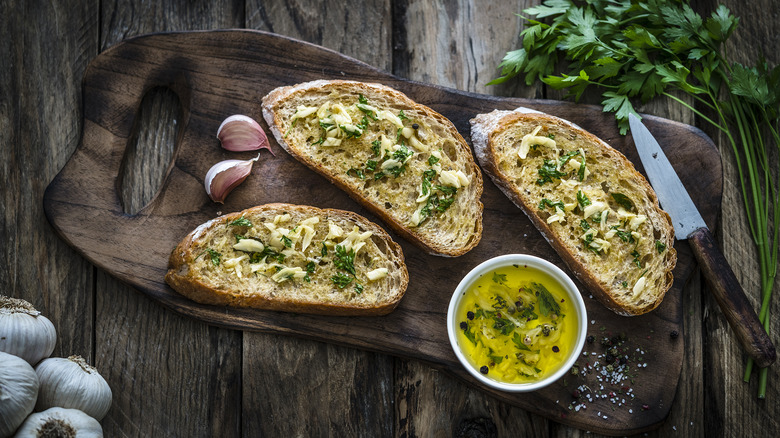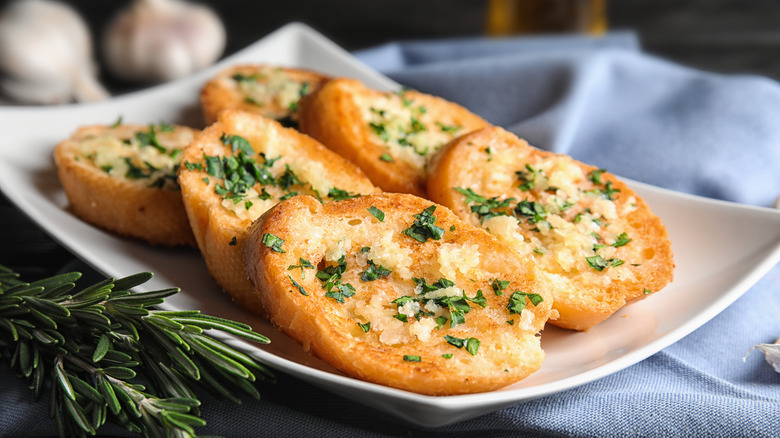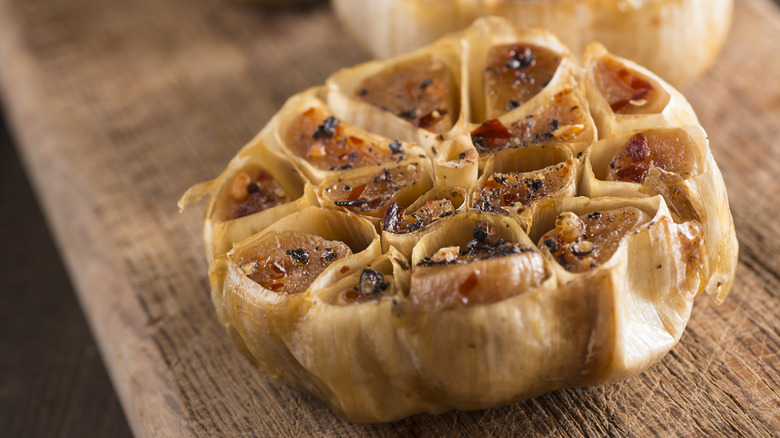Garlic Bread Isn't All That Italian, Despite What You May Think
It's pretty unusual to go to an Italian restaurant and not see any sign of garlic bread on the menu. This buttery, sometimes cheesy bread has become a staple to serve alongside almost any Italian dish, from pasta to egglplant parm, and, as such, it's been well-associated with the European country for years. But, if you trace garlic bread back to its roots, you'd be surprised to learn that this dish did not actually originate in Italy. Rather, it's an Italian-American dish that took inspiration from another popular appetizer: bruschetta.
Garlic bread became popular in the mid-20th century; Italians began opening restaurants to serve their cuisine, including pizza and pasta, and garlic bread was a natural addition to the menu. Before that, though, nobody wanted to use garlic — Americans didn't love its heavy scent and pungent raw flavor. But thanks to a spike in Italian-American restaurants as well as Julia Child's cooking (which often included garlic) in the 1960s, this bulb vegetable is now a household staple.
Garlic bread's origin story
When Italians immigrated to the United States, they brought their bruschetta recipes with them. We know traditional Italian bruschetta as being made with tomatoes, but in its original form, tomatoes were not used. The dish was primarily made with bread that was starting to go stale as a way of using it up, with a little olive oil and garlic. The garlic was rubbed on from a raw clove rather than crushed or minced and baked on top of the bread. Of course, that holds much similarity to the garlic bread we know and love today, though most Americans opt for fresh bread.
But good olive oil wasn't as readily available as butter in the U.S.; butter could easily be churned in less than an hour, so people began making the dish with butter instead. And so began the American variation of bruschetta, which came to be known as garlic bread. It's unclear exactly how the dish got its American name, though it could be that it was a simple, forward way of describing the snack.
Americans have modified other Italian dishes, too
Over the years, garlic bread went from raw garlic on stale bread to garlic that's baked over fresh bread while it toasts. But that's not the only time Americans have modified popular Italian dishes. If you've ever ordered fettuccine Alfredo at a restaurant in the United States, you've probably received a dish made from cream, parmesan, and butter tossed with pasta. But in its original form, which was invented in Rome by chef Alfredo Di Lelio, the dish contains just butter and parmesan — no cream; it's still prepared in Italy this way today.
Pizza has certainly been modified as well, with its ingredients in the U.S. differing from how it's made in Italy. In the U.S., it's common for pizza dough to contain shortening or vegetable oil, while olive oil is the choice in Italy. The flour of choice is tipo 00 in Italy, but that isn't always easy to find in the U.S., so higher-gluten flour is often used instead. That's why dough in Italy usually tastes lighter and fresher than dough in the U.S. Plus, tomato sauce in Italy contains less sugar than it does in the United States.


